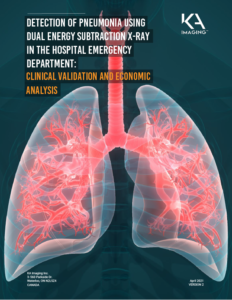
Diagnosing and treating pneumonia has become a pressing concern in these pandemic times. Although dual energy subtraction (DES) has been shown to detect more pneumonia and other health concerns in chest X-rays than conventional X-ray, systems are not widely used due to specific limitations. New technology now overcomes previous issues, including portability, and pneumonia trials are showing promising results.
The early detection of pneumonia could help reduce hospitalization costs, minimize patient movement in the hospital, and improve bed availability, along with other health and economic benefits. Download the white paper to learn more.
In the USA, one million people are hospitalized annually for pneumonia and although 95% recover, there is a $9.5 billion dollar cost to the hospitals that is associated with the hospital stay and procedures (e.g., ventilation) or roughly ten thousand dollars per patient on average. Around 80% of the pneumonia patients present through the emergency room, 30% are either self-insured or not insured in the USA and nearly 10% are readmitted within a month1.
The situation is not so different in Canada. Recently published CIHI data2 on annual emergency department visits show that although pneumonia is ranked only 9th out of 10 top reasons for emergency department visits, it results in a disproportionate 36% of total admitted patients from the emergency department. With the rise in infectious COVID-19 pneumonia, this situation has only grown worse and given the infectious nature of COVID-19 pneumonia, reduced patient mobility for routine imaging tasks and shrinking intensive care unit (ICU) bed capacity are both emerging concerns.
1. Divino, V., et al “The annual economic burden among patients hospitalized for community-acquired pneumonia (CAP): a retrospective US cohort study.” Current Medical Research and Opinion 36, no. 1 (2020): 151-160.
2. 3 https://www.cihi.ca/en/search?query=NACRS+Emergency&Search+Submit=
Media Inquiries
